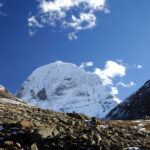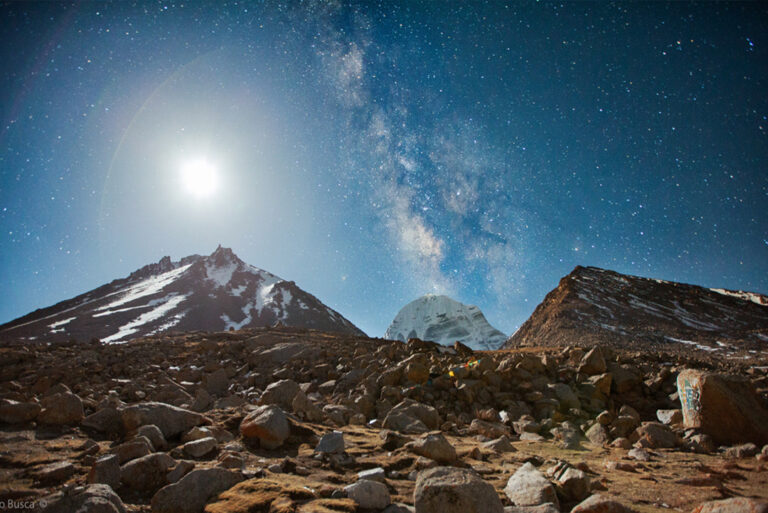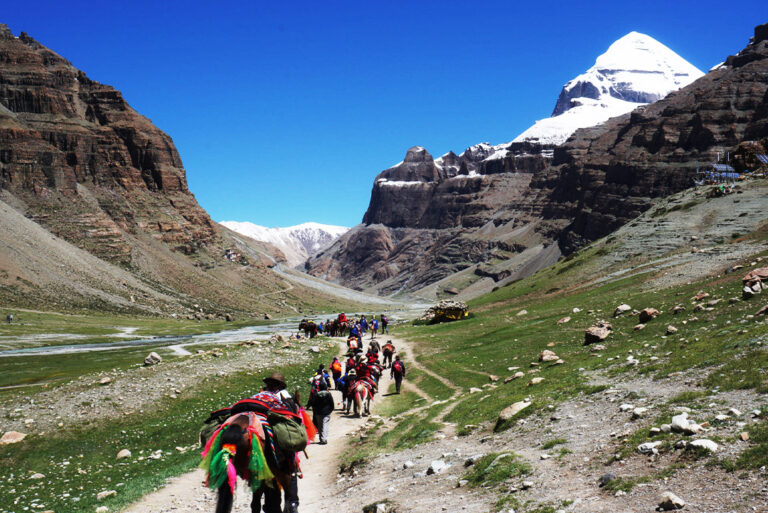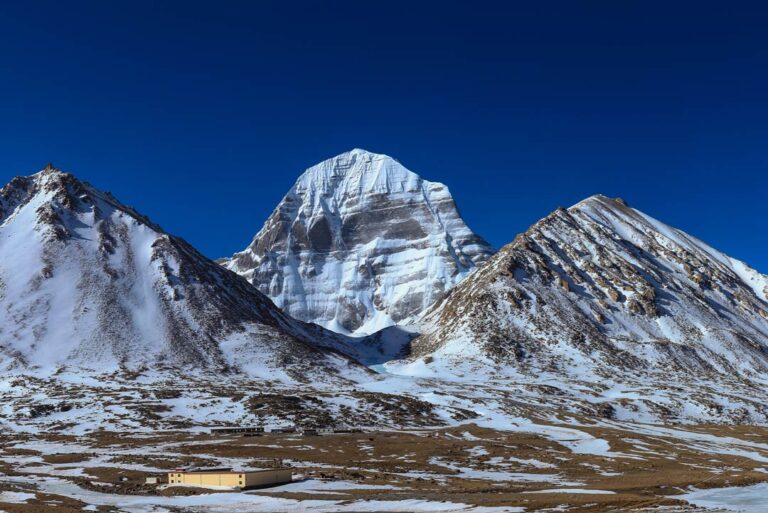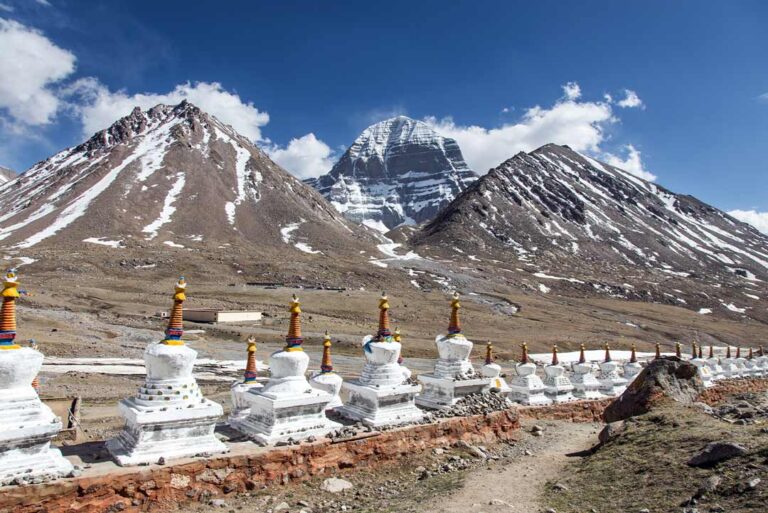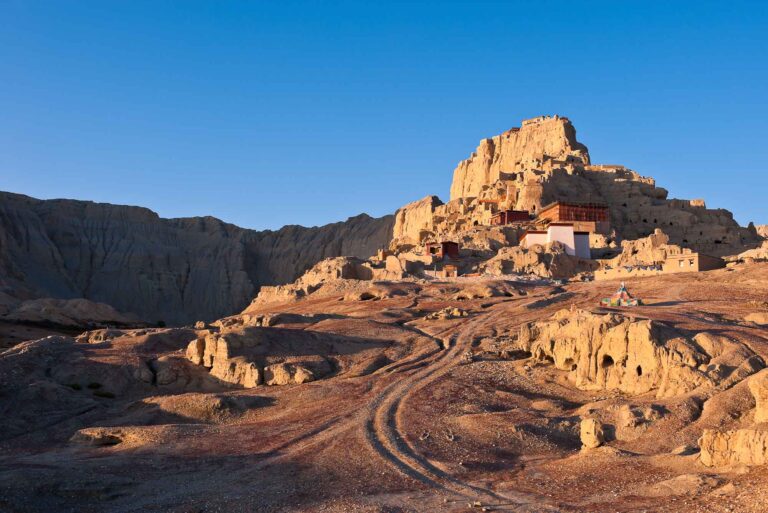Mount Kailash A Mountain of Unsolved Mysteries. Mount Kailash, often referred to as the heavenly abode of Lord Shiva, stands tall in the southwestern part of Tibet, near the Kumaon region of India. This sacred mountain, known for its four crystal-like faces, holds a profound significance in Hinduism and Buddhism. Its towering presence, surrounded by the rugged landscapes of the Tibetan plateau, invokes a sense of divine energy that has captivated spiritual seekers for centuries. The very name “Kailash” translates to ‘crystal’ in Sanskrit, underscoring the ethereal quality attributed to this peak.
As a central figure in Hindu mythology, Lord Shiva is believed to reside at the summit of Mount Kailash in deep meditation, symbolizing the unity of the earthly and divine realms. The mountain’s prominence extends into Buddhism, where it is known as Mount Meru, a sacred site associated with enlightenment. Pilgrims from various corners of the world undertake arduous journeys to witness the majestic beauty of Mount Kailash, seeking spiritual solace and a connection with the divine. The unique geological features of the mountain, coupled with its mythological significance, create an aura of mystery that beckons both religious devotees and curious explorers alike.
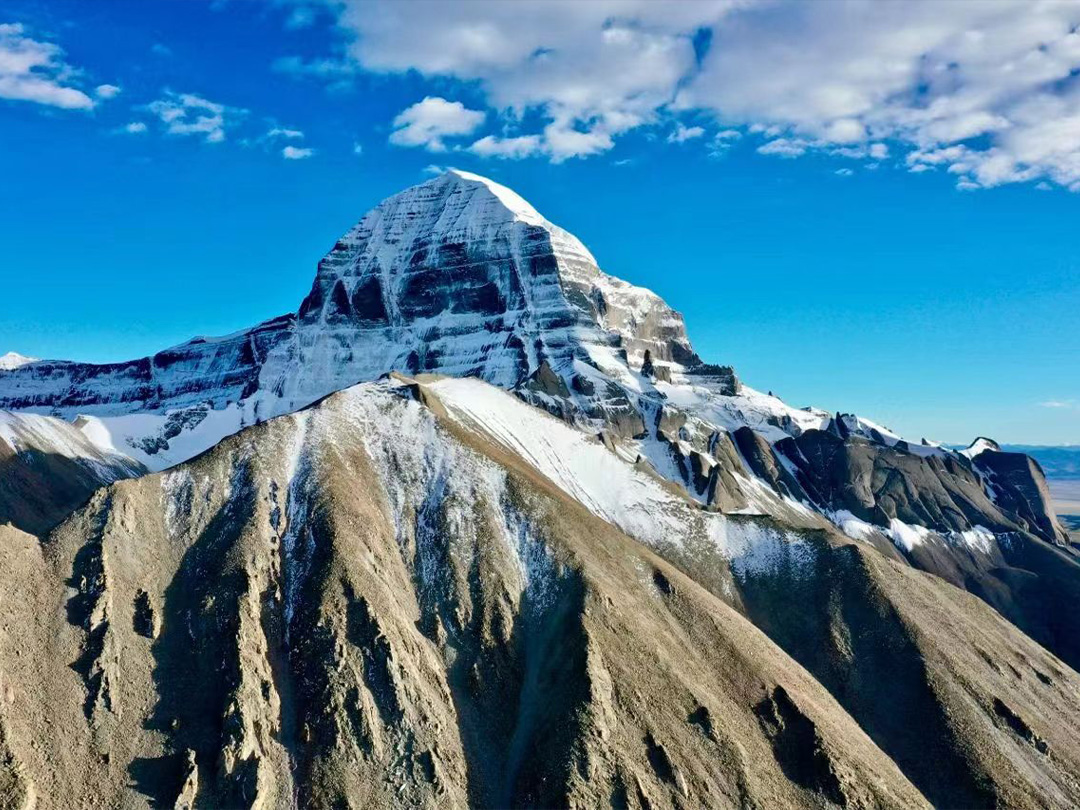
Mythological Background
According to Hindu scriptures, Mount Kailash stands as the Axis Mundi, a cosmic axis where the heavens and the earth converge. This sacred mountain holds profound significance as the meeting point of divine energies and mortal existence. Lord Shiva, revered as the Adi Yogi, is believed to choose the summit of Mount Kailash as his seat for deep transcendental meditation. This sacred act is thought to infuse the entire region with spiritual potency, creating an environment that resonates with cosmic energies. Pilgrims from various corners of the world embark on journeys to Mount Kailash, seeking to connect with the divine presence believed to permeate the mountain’s core.
The idea of Mount Kailash as the Axis Mundi transcends geographical and physical dimensions, symbolizing a bridge between the earthly realm and the celestial abode. The mythology surrounding this mystical mountain not only elevates it to a sacred pedestal in Hinduism but also inspires a sense of reverence and awe among those who recognize its spiritual importance. The belief in Lord Shiva’s perpetual meditation atop Mount Kailash contributes to the mountain’s status as a timeless beacon of transcendence and a testament to the intersection of the divine and the mortal in the tapestry of Hindu cosmology.
Contrasting Water Bodies in Near Vicinity
Situated in close proximity to Lake Manasarovar, Mount Kailash’s geographical location adds to its mystical aura. The turquoise Mansarovar, shaped like the sun, and the crescent-shaped Rakshas Taal are connected by the Ganga Chuu channel, each holding its unique significance. Lake Manasarovar, often referred to as the “brightness,” is considered one of the holiest lakes in Hinduism. Legend has it that the lake was first formed in the mind of Lord Brahma, and it is here that Lord Shiva and Lord Brahma appeared in the form of swans. The pristine water of Mansarovar is believed to possess the divine power to wash away sins, making it a destination for pilgrims seeking spiritual purification.
In contrast, Rakshas Taal, shaped like a crescent, is associated with negativity. According to Hindu scriptures, the demon king Ravana, seeking the favor of Lord Shiva, performed intense penance at the foothills of Mount Kailash. Ravana’s offerings and sacrifices near Rakshas Taal, including the daily sacrifice of one of his ten heads, resulted in the lake acquiring a reputation for harboring negative energies. The juxtaposition of Mansarovar and Rakshas Taal, both connected by the Ganga Chuu channel, contributes to the duality and mystique surrounding Mount Kailash’s sacred landscape.
Connection Between Mansarovar and Rakshas Taal
In the mystical expanse surrounding Mount Kailash, the divine juxtaposition of Mansarovar and Rakshas Taal captivates pilgrims and travelers alike. Mansarovar, revered as a sacred body of water, is esteemed for its holiness and the belief that its waters possess purifying properties. Pilgrims embark on journeys to immerse themselves in the spiritual aura of Mansarovar, seeking purification and a connection with the divine.
On the contrary, Rakshas Taal stands in stark contrast, carrying an air of negativity in its crescent-shaped waters. The association of Rakshas Taal with ominous energies adds an intriguing layer to the spiritual tapestry of the region. What adds to the mystique is the intertwining of these contrasting lakes through the Ganga Chuu channel, forming a unique link between purity and negativity. This enigmatic connection between Mansarovar and Rakshas Taal adds a deeper layer of fascination to the spiritual narratives and cultural beliefs surrounding Mount Kailash
NASA’s Observation
Recent claims propose that NASA scientists have purportedly witnessed the visage of Lord Shiva on Mount Kailash, linking this phenomenon to the magnetic forces prevalent in the region. Supporters of this assertion contend that the sacred mountain might possess unique magnetic properties, giving rise to spiritual or divine appearances. On the contrary, skeptics cast doubt on the veracity of these claims, asserting that the observed phenomena could be more plausibly explained by natural atmospheric or geological conditions. They suggest that optical illusions or peculiarities in the mountain’s terrain might be responsible for the perceived resemblance to the face of Lord Shiva, emphasizing the need for a more empirical and scientific examination of such occurrences.
Himalayan Rivers
Mount Kailash is revered as the origin of several significant Himalayan rivers, such as the Brahmaputra, Indus, Sutlej, and Karnali. According to ancient mythology, the mountain is adorned with symbolic animal faces on its four directions, each representing the auspicious starting points of these mighty rivers.
The profound belief in Mount Kailash being the source of these revered rivers is deeply rooted in cultural and religious narratives. The symbolism of animal faces not only adds to the mystique surrounding the mountain but also underscores the spiritual and geographical interconnectedness attributed to this sacred peak.
Pyramid-Shaped Mountain
Intriguingly, Russian scientists have put forth a distinctive theory proposing that Mount Kailash takes on the form of a colossal pyramid encircled by smaller pyramids. This unconventional perspective suggests that the mountain’s unique structure might not be the result of natural geological processes but instead could be a purposefully constructed vacuum pyramid. The implications of this theory raise significant questions about the mountain’s origin, challenging traditional notions of how such awe-inspiring natural formations come into existence.
This novel interpretation by Russian scientists introduces an element of mystery and speculation into the discourse surrounding Mount Kailash, transforming it from a conventional mountain to a potential enigma of ancient engineering or, as some theorists posit, even an extraterrestrial artifact. As researchers delve deeper into this hypothesis, the narrative around Mount Kailash expands beyond its spiritual and cultural significance to encompass the intriguing possibility of it being a unique and deliberately crafted structure, inviting further exploration and investigation.
Climbing Restrictions and Historical Attempts
Climbing Mount Kailash is a venture strictly forbidden, a rule held in reverence by spiritual traditions. Throughout history, only a handful of individuals have dared to defy this prohibition. Among them is Milarepa, a Tibetan Buddhist yogi, who stands as the sole recorded person to have ascended the sacred mountain and lived to share the tale. Milarepa’s unique accomplishment, however, was accompanied by a solemn warning. He passionately discouraged others from attempting the ascent, underscoring the profound disturbance such actions could inflict upon the deity believed to be in serene repose at the summit.
This spiritual directive echoes through the ages, reinforcing the sanctity attributed to Mount Kailash and emphasizing the delicate balance between the sacred and the mundane. Despite the allure of conquering this revered peak, the prevailing wisdom, as imparted by Milarepa, urges restraint, urging pilgrims and adventurers alike to honor the spiritual significance that envelops the majestic Mount Kailash.
Aircraft Restrictions
Mysterious forces, unbeknownst to scientists and aviators alike, create an intriguing phenomenon that restricts aircraft from flying over Mount Kailash beyond a particular elevation. Even with the advancements in aeronautics, this enigmatic restriction persists, confounding experts and contributing to the mountain’s mystical aura. The inexplicable nature of this airborne restriction becomes another layer of intrigue surrounding Mount Kailash, prompting speculation and deepening the mystery that envelops this sacred peak.
Despite the relentless pursuit of scientific understanding, the reasons behind this phenomenon continue to elude explanation, leaving a captivating element of uncertainty within the broader tapestry of Mount Kailash’s mysticism.
Reports of Aging and Instant Death
Reports of aging and instant death linked to Mount Kailash have sparked intriguing anecdotes among tourists and climbers. According to these accounts, some visitors to Mount Kailash claim to undergo unusual physiological changes, such as accelerated growth in nails or hair. The mystical aura surrounding the ancient peak is said to have a transformative effect on those who venture into its vicinity, leaving them with physical alterations that defy conventional explanations.
In more astonishing tales, climbers from Siberia are said to have experienced a phenomenon where they aged by decades instantly upon reaching a specific point on Mount Kailash. The sudden and drastic aging reported by these individuals has become a topic of speculation and fascination. These stories add a layer of mystique to the already enigmatic mountain, prompting further inquiry into the inexplicable occurrences that seem to be associated with the sacred site.
Conclusion Mount Kailash A Mountain of unsolved Mysteries
In conclusion, Mount Kailash remains a captivating blend of religious beliefs and unexplained phenomena. Whether it’s the mythological connections, the pyramid shape, or the restrictions on climbing and flying, the mountain continues to be shrouded in mystery, inviting both spiritual contemplation and scientific inquiry.
FAQs Mount Kailash A Mountain of unsolved Mysteries
Can tourists visit Mount Kailash?
Tourists are welcome to explore the captivating region surrounding Mount Kailash, soaking in the cultural and natural wonders that abound in this sacred area. The breathtaking landscapes, including the mystical Lake Mansarovar and the crescent-shaped Rakshas Taal, offer a profound experience for those seeking spiritual and adventurous journeys. However, it’s essential to note that the sacredness of Mount Kailash itself is preserved through strict regulations, prohibiting any attempts to climb the revered mountain. Visitors are encouraged to respect these restrictions and appreciate the awe-inspiring beauty of Mount Kailash from a respectful distance.
While the region welcomes those eager to witness the unique charm of Mount Kailash, the spiritual sanctity of the mountain remains paramount. Climbing the sacred peak is off-limits, as it holds deep religious significance in Hinduism, Buddhism, and other belief systems. This prohibition is in place to maintain the sacredness and tranquility of Mount Kailash, ensuring that its spiritual essence is preserved for pilgrims, devotees, and nature enthusiasts alike.
What is the significance of Lake Mansarovar?
Lake Mansarovar holds immense significance in Hinduism, revered as a sacred body of water with profound spiritual importance. It is considered a holy lake, and its tranquil waters are believed to possess purifying properties according to Hindu religious beliefs. Devotees hold the belief that immersing oneself in the pure waters of Mansarovar can cleanse the soul and wash away sins, contributing to a heightened state of spiritual purity. The serene and pristine nature of Lake Mansarovar adds to its sanctity, making it a destination for pilgrims seeking spiritual rejuvenation and a connection to the divine..
Are there any scientific explanations for the phenomena on Mount Kailash?
While certain aspects, like the restrictions on aircraft flying over the sacred mountain, continue to perplex researchers and scientists, concrete scientific explanations remain elusive. Despite advancements in various fields, the mysterious force that prevents planes from proceeding beyond a specific elevation around Mount Kailash remains unexplained, fostering ongoing speculation and curiosity within the scientific community.
Some phenomena, such as aircraft restrictions, are yet to be scientifically explained, leading to ongoing speculation. The peculiar nature of these unexplained occurrences, including the invisible force affecting aviation, prompts researchers to delve deeper into the mysteries surrounding Mount Kailash. As scientists strive to understand the enigmatic forces at play in this sacred region, the lack of definitive answers contributes to the enduring allure and mystique of the mountain.
Has anyone else besides Milarepa climbed Mount Kailash?
In the annals of history, there is a noteworthy mention of another individual venturing to climb the sacred Mount Kailash. According to historical accounts, Yudhisthira, a central figure in the Mahabharata, embarked on the ascent of this revered mountain. His daring journey was accompanied by a unique companion—a dog, believed to embody the divine presence of God Yama. This narrative from ancient Hindu epics adds an intriguing layer to the mystique surrounding Mount Kailash, showcasing that the allure of this sacred peak has captivated not only spiritual seekers like Milarepa but also figures from epic tales deeply ingrained in cultural heritage.
Yudhisthira’s quest for spiritual elevation, symbolized by the challenging climb up Mount Kailash, resonates with the broader theme of seeking transcendence and divine connection in Hindu mythology. The shared reverence for this majestic mountain across different narratives emphasizes its timeless significance in the spiritual and cultural tapestry of the region.
Is Mount Kailash considered an ancient alien spacecraft?
Is Mount Kailash regarded as an ancient alien spacecraft? Several theories have suggested this intriguing idea, sparking curiosity and speculation. However, it’s essential to note that despite the speculation, there is a lack of scientific evidence substantiating the claim that Mount Kailash is, indeed, an ancient alien spacecraft.
While some enthusiasts delve into the possibility of Mount Kailash having extraterrestrial origins, the scientific community remains skeptical. The absence of empirical evidence challenges the notion, emphasizing the importance of distinguishing between imaginative theories and substantiated facts when exploring the mysteries surrounding this sacred mountain.

